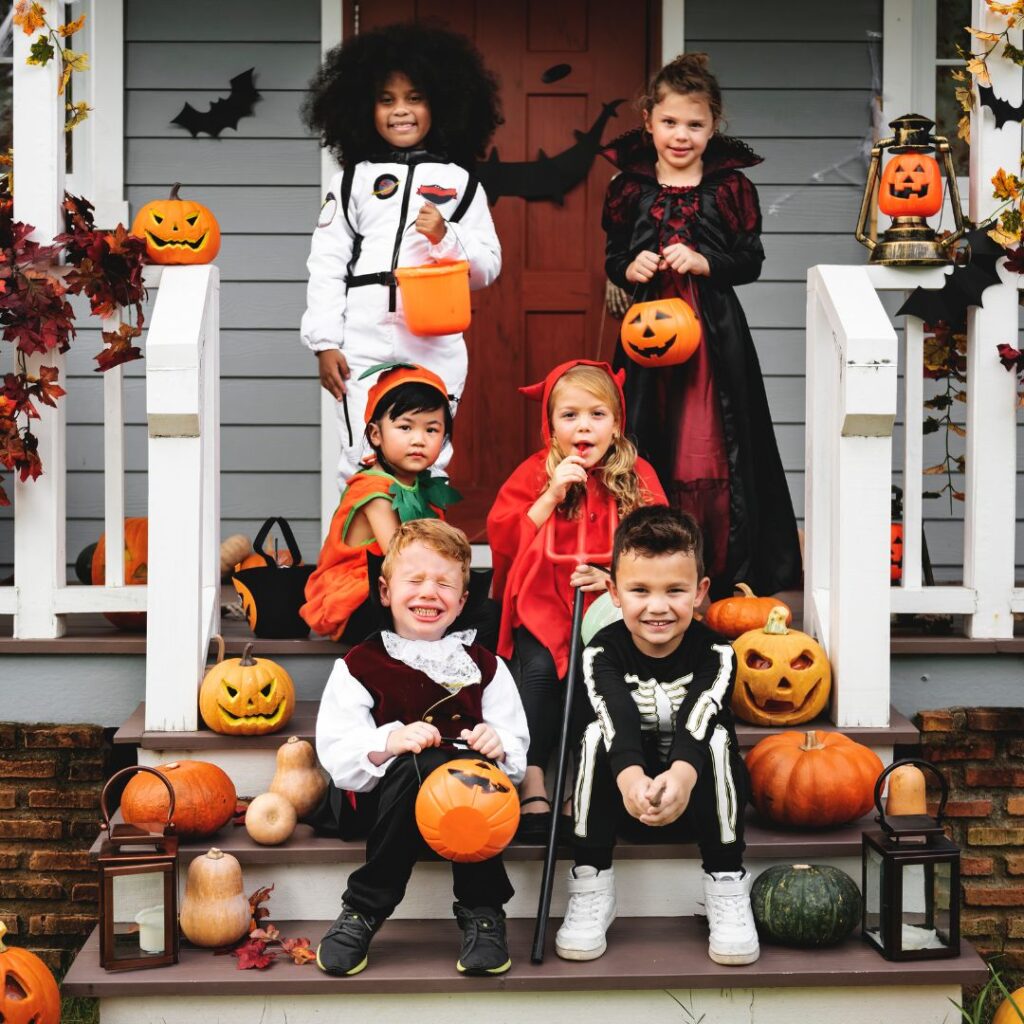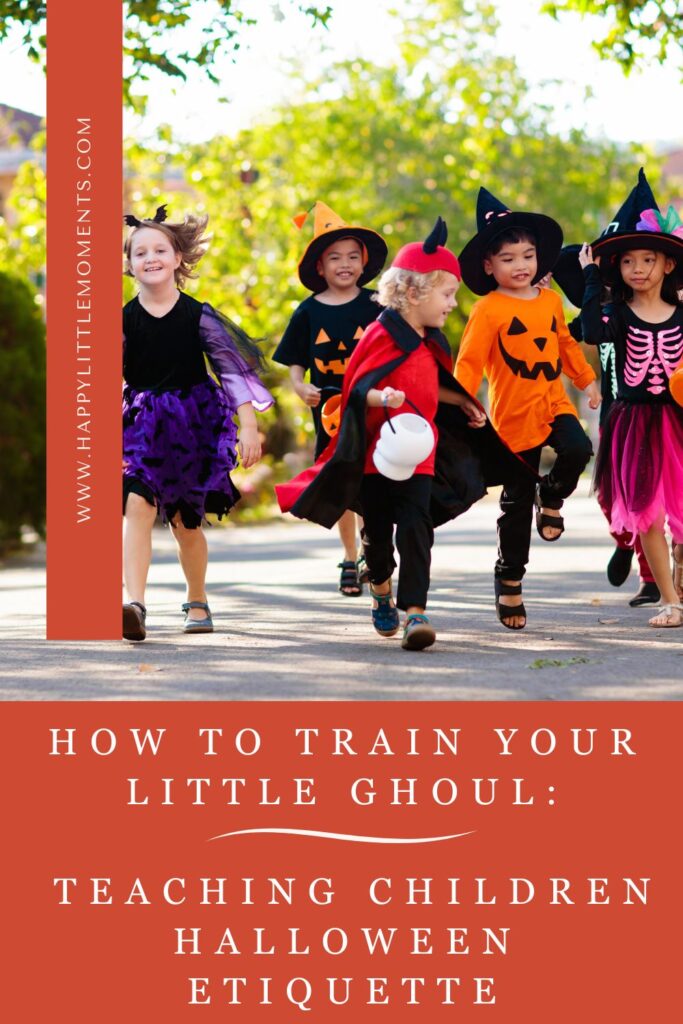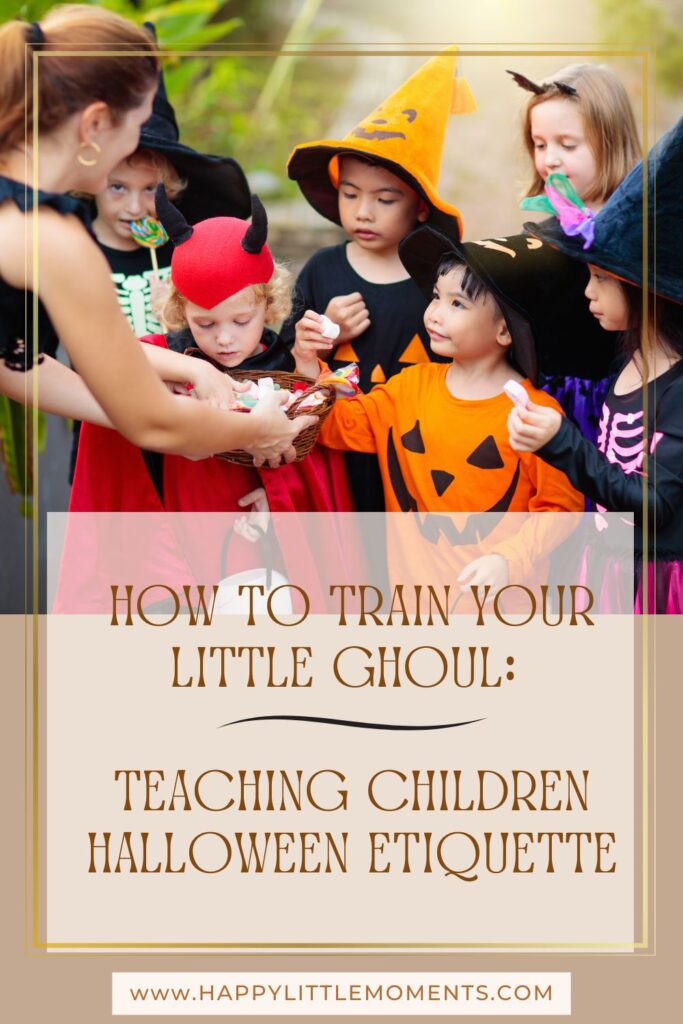happy little moments





How to Train Your Little Ghoul: Teaching Children Halloween Etiquette
Ghosts and goblins may love a little mischief, and Halloween is all about fun–but Halloween is also a great time to brush up on some Halloween etiquette rules with our children. Halloween is such an exciting night for our kids. What child doesn’t love an evening when it’s their job to dress up in disguise, go door to door, and stockpile candy? But let’s not forget to teach them a few simple rules that will make the whole night smoother for our friends, neighbors, and even us parents!
What is Halloween Etiquette?
Halloween Etiquette is simply behaving in a way that is respectful and courteous to adults, neighbors, and other children, which helps everyone experience a safe and fun Halloween night. As a new parent just a few short years ago, I didn’t think too much about “Halloween Etiquette” per se. I simply thought there are polite social norms that most people live by, including children. But on my first Halloween out with kids, I noticed a lack of what one might call “Halloween Etiquette” from many children. It became clear to me that things that I thought were impolite are not innate to children, and many parents aren’t teaching Halloween manners.
Children who demonstrate good Halloween etiquette make their neighbors and fellow Trick-or-Treaters feel good about themselves and the world we live in. Halloween etiquette includes being mindful of the other Trick-or-Treaters around us, respecting other people’s property and privacy, participating in fun Halloween traditions, and saying our pleases and thank-yous.
However, don’t get me wrong–I understand that kids will be kids sometimes. None of our children are perfect and neither are parents. Sometimes, children have a bad day. My children have faux pas-ed numerous times, even though my husband and I emphasize teaching our children good manners. But, as parents, let’s be proactive this year and take the time to teach our children some simple rules and boundaries on Halloween.
12 halloween etiquEtte rules to teach our children

1. trick-or-treaters should wear costumes.
Children should participate in the tradition of wearing Halloween costumes if they are Trick-or-Treating. Of course, people generally understand if there’s a special need or other legitimate reason why a child is not wearing a costume. But overall, our children should participate in the costume-wearing festivities if they plan to Trick-or-Treat. Not only is it fun for our kids, but it brings joy to others who are handing out candy.
2). encourage Children to say "Trick-or-Treat."
First of all, teaching your child to say this one little phrase is a great opportunity to help your child build some courage and confidence, especially if your child is bashful. On Halloween night, children are among friends and are not asking for anything unexpected. So having them say something as simple as “Trick-or-Treat” is great for building their confidence and getting them to speak-up. For little ones that are especially shy, practice role-playing at home a day or two beforehand so they’ll have more self-assurance on Halloween night.
3). Teach children to say "Thank You."
If there are people at the house giving out candy, remind your child to say thank you to them. Teaching children to be thankful for what they receive will help them grow into happier adults. It’s been proven that people who regularly express gratitude have better overall well-being. Of course, we want our children to be happy and enjoy life to the fullest, even when they’re grown. Gratefulness is a lesson that is a must for our children to learn, and Halloween is one of the many times children can learn to express thankfulness.
4). Be Aware of other Trick-or-Treaters
I admire the “can-do” attitude and even the assertiveness of many kids. If a child wants something, they go for it without a second thought. However, in the excitement of Halloween, this can mean a full-on charge toward the front door of every house, pushing past other kids or even knocking over neighborhood decorations. We all want Halloween to be safe for our children, so it’s key to have a conversation beforehand about respectful behavior toward other children. If you reinforce this with your child while they are young, they will keep these manners when they eventually go Trick-or-Treating on their own someday.
5). Be Mindful of the neighbor's property
Teach your children to stay on the sidewalks and driveways and to stay off of lawns and streets. Not only does this teach our children to respect the property of others, but it also keeps them safe. If a child is trampling on someone’s yard, they are much more likely to trip and fall. Additionally, teach your children not to mess with neighbors’ Halloween decorations and to be mindful not to knock any decorations over.

6). Teach Your Child to Take One Piece of Candy.
When there’s the inevitable unmanned bucket of candy, teach your child to only take one piece of candy from it. Explain that the bucket of candy is for all Trick-or-Treaters who pass by. We must save some for others. It’s important to teach our children to be aware of being kind and respectful to the other Trick-or-Treaters.
Kids aren’t naturally tuned in to how their actions affect others—it’s something we have to teach them. A simple conversation, like explaining why grabbing handfuls of candy might leave less for the kids who come later, can really get them thinking. This helps engage their brains in a way that teaches them to consider the bigger picture, beyond just the moment. By encouraging this kind of deeper thinking—what we call 2nd, 3rd, and even 4th order thinking—we’re setting them up to make smarter choices down the road. After all, we want our kids to grow into thoughtful adults who can think ahead and avoid making decisions they might regret later.
7). Pass by dark houses.
Teach children that not everyone wants to be a part of Halloween. Some people have perfectly valid religious reasons for not participating or they may be out Trick-or-Treating with their own children. It’s best to pass by the dark houses because they are not passing out candy, and they may not wish to be bothered on Halloween night.
8). Ring the doorbell only once or twice.
If the weather isn’t cooperating, adults handing out candy may be inside their homes. If a house has its porchlight on and no one is outside, it’s okay to ring the doorbell. But only do so once or maybe twice. Teach your children that it’s impolite to ring the doorbell repeatedly. That house may be out of candy, they may not want any guests, or they may have left the porch light on by mistake.
9). Trick-or-Treat Only During Designated Hours.
Check the neighborhood or city’s Trick-or-Treating hours, and don’t allow your children to Trick-or-Treat outside those hours. First of all, if you go Trick-or-Treating too early, the neighbors may not be ready yet. If you’re out too late, the neighbors may be out of candy or getting ready for bed. Be aware of the hours you choose for Trick-or-Treating.
10). Never complain about the candy given.
Let’s teach our children to be grateful for what they receive. While it’s natural for a child to have candy preferences, it’s impolite to complain about the candy you’ve received. If they don’t like the candy given, teach them to say thank you and move on to the next house without complaint. Discuss that all neighbors are being kind by giving out gifts and candy, even if what is given is not their favorite.
11). Supervise Young Children.
As adults, we must supervise our young children for their safety and to teach them proper Halloween manners. Take them out of Trick-or-Treating and remain vigilant. Have conversations about how to be polite, say thank-you, and how to behave respectfully toward others. Remember, our little kids are unlikely to be perfect, especially with all of the excitement, but it’s important to have these conversations early so they will learn the social expectations over time.
12). Big Kids Trick-or-Treating.
Honestly, I have no issue with children who want to continue Trick-or-Treating beyond what others may consider “too old.” Let’s let our kids be kids as long as they can be. However, there are exceptions. Older kids must not be out causing trouble or bullying younger children if they want to continue their Halloween Trick-or-Treating tradition. Halloween must remain about childhood magic, wonder, and suspension of disbelief, even for older kids. But let’s allow these children to be children as long as they can be, provided they are Trick-or-Treating respectfully.
As the excitement of Halloween builds, it’s easy to focus on costumes, candy, and spooky decorations, but there’s more to this holiday when it comes to kids. By teaching our children the basics of Halloween etiquette, we’re helping the night run smoothly and giving them lifelong lessons in responsibility, respect, and kindness. These little reminders—like saying ‘thank you’ at each doorstep, respecting boundaries, and following the rules—help them engage with the world around them without screens. Plus, practicing good manners boosts their confidence as they interact with neighbors and friends.
So, as you get your family ready for a fun night of trick-or-treating, remember that these lessons go beyond just Halloween. They’re small, everyday opportunities to help your children grow into thoughtful, respectful, and confident people. Here’s to a Halloween filled with lots of candy, spooky fun, and a healthy dose of good manners. Happy trick-or-treating!
Save this post for later! Click the pins to save to your Pinterest Account! Follow me if you found this post helpful.




